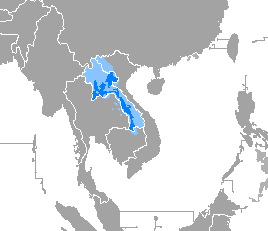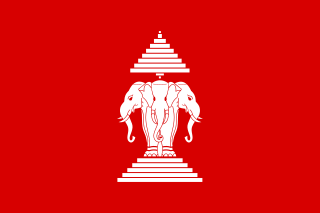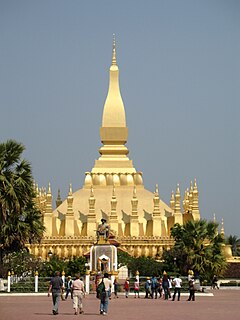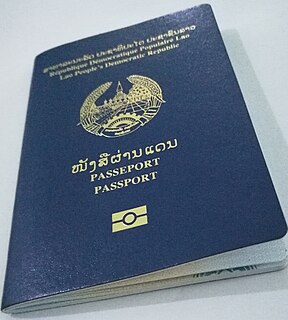
Laos, officially the Lao People's Democratic Republic, is a socialist state and the only landlocked country in Southeast Asia. At the heart of the Indochinese Peninsula, Laos is bordered by Myanmar and China to the northwest, Vietnam to the east, Cambodia to the southeast and Thailand to the west and southwest.

Lao Tzu, also rendered as Laozi and Lao-Tze, was an ancient Chinese philosopher and writer. He is the reputed author of the Tao Te Ching, the founder of philosophical Taoism, and a deity in religious Taoism and traditional Chinese religions.

Lao, sometimes referred to as Laotian, is a Kra–Dai language of the Lao people. It is spoken in Laos, where it is the official language for around 7 million people, as well as in northeast Thailand, where it used by around 23 million people, usually referred to as Isan. Lao serves as a lingua franca among the citizens of Laos, who also speak approximately 90 other languages, many of which are unrelated to Lao.
The Lao people are a Tai ethnic group native to Southeast Asia, who speak the eponymous language of the Kra–Dai languages, originating from present-day southern China. They are the majority ethnic group of Laos, making up 53.2% of the total population. The majority of Lao people adhere to Theravada Buddhism. They are closely related to other Tai peoples, especially with the Isan people, who are also speakers of Lao language, but native to neighboring Thailand.

The Kingdom of Laos was a constitutional monarchy that served Laos beginning with its independence on 9 November 1953. The monarchy survived until December 1975, when its last king, Sisavang Vatthana, surrendered the throne to the Pathet Lao, who abolished the monarchy in favour of a Marxist–Leninist state called the Lao People's Democratic Republic, which has controlled Laos ever since.

The Pathet Lao, officially the Lao People's Liberation Army, was a communist political movement and organization in Laos, formed in the mid-20th century. The group was ultimately successful in assuming political power in 1975, after the Laotian Civil War. The Pathet Lao were always closely associated with Vietnamese communists. During the civil war, it was effectively organized, equipped and even led by the People's Army of Vietnam (PAVN). They fought against the anti-communist forces in the Vietnam War. Eventually, the term became the generic name for Laotian communists.

The Laotian Civil War (1959–1975) was a civil war in Laos which was waged between the Communist Pathet Lao and the Royal Lao Government from 23 May 1959 to 2 December 1975. It is associated with the Cambodian Civil War and the Vietnam War, with both sides receiving heavy external support in a proxy war between the global Cold War superpowers. It is called the Secret War among the CIA Special Activities Center and Hmong veterans of the conflict.

Lao cuisine or Laotian cuisine is the cuisine of Laos, which is distinct from other Southeast Asian cuisines.
Lao script or Akson Lao is the primary script used to write the Lao language and other minority languages in Laos. Its earlier form, the Tai Noi script, was also used to write the Isan language, but was replaced by the Thai script. It has 27 consonants, 7 consonantal ligatures, 33 vowels, and 4 tone marks.

Lao Airlines State Enterprise is the national airline of Laos, headquartered in Vientiane. It operates domestic and international services to countries such as Cambodia, China, Japan, South Korea, Thailand, and Vietnam. Its main operating base is Wattay International Airport in Vientiane. It is subordinate to the Ministry of Public Works and Transport.

Kung Lao is a fictional character in the Mortal Kombat fighting game franchise by Midway Games and NetherRealm Studios. A Shaolin monk, he debuted in Mortal Kombat II (1993). He is depicted as a primary hero in the series, including as one of the protagonists of the action-adventure spin-off Mortal Kombat: Shaolin Monks (2005). The character is also a descendant of the Great Kung Lao, the first Earthrealm champion of the Mortal Kombat tournament. His main weapon is a metal hat, which he uses for both melee and projectile attacks.

Laos developed its culture and customs as the inland crossroads of trade and migration in Southeast Asia over millennia. As of 2012 Laos has a population of roughly 6.4 million spread over 236,800 km2, yielding one of the lowest population densities in Asia. Yet the country of Laos has an official count of over forty-seven ethnicities divided into 149 sub-groups and 80 different languages. The Lao Loum have throughout the country's history comprised the ethnic and linguistic majority. In Southeast Asia, traditional Lao culture is considered one of the Indic cultures.

Theravada Buddhism is the largest religion in Laos, which is practiced by 66% of the population. Lao Buddhism is a unique version of Theravada Buddhism and is at the basis of ethnic Lao culture. Buddhism in Laos is often closely tied to animist beliefs and belief in ancestral spirits, particularly in rural areas.

Lao-Lao is a Laotian rice whisky produced in Laos. Along with Beerlao, lao-Lao is a staple drink in Laos.

The French protectorate of Laos was a French protectorate in Southeast Asia of what is today Laos between 1893 and 1953—with a brief interregnum as a Japanese puppet state in 1945—which constituted part of French Indochina. It was established over the Siamese vassal, the Kingdom of Luang Phrabang, following the Franco-Siamese War in 1893. It was integrated into French Indochina and in the following years further Siamese vassals, the Principality of Phuan and Kingdom of Champasak, were annexed into it in 1899 and 1904, respectively.
Thai Braille (อักษรเบรลล์) and Lao Braille (ອັກສອນເບຣລລ໌) are the braille alphabets of the Thai language and Lao language. Thai Braille was adapted by Genevieve Caulfield, who knew both English and Japanese Braille. Unlike the print Thai alphabet, which is an abugida, Thai and Lao Braille have full letters rather than diacritics for vowels. However, traces of the abugida remain: Only the consonants are based on the international English and French standard, while the vowels are reassigned and the five vowels transcribed a e i o u are taken from Japanese Braille.
North Vietnam supported the Pathet Lao to fight against the Kingdom of Laos between 1958–1959. Control over Laos allowed for the eventual construction of the Ho Chi Minh Trail that would serve as the main supply route (MSR) for enhanced NLF and NVA activities in the Republic of Vietnam. As such, the support for Pathet Lao to fight against Kingdom of Laos by North Vietnam would prove decisive in the eventual communist victory over South Vietnam in 1975 as the South Vietnamese and American forces could have prevented any NVA and NLF deployment and resupply if these only happened over the 17th Parallel, also known as the Demilitarized Zone (DMZ), a narrow strip of land between North and South Vietnam that was closely guarded by both sides. It also helped the Pathet Lao win the Kingdom of Laos, although the Kingdom of Laos had American support.

Vientiane is the capital and largest city of Laos, on the banks of the Mekong River near the border with Thailand. Vientiane became the capital in 1573, due to fears of a Burmese invasion, but was later looted, then razed to the ground in 1827 by the Siamese (Thai). Vientiane was the administrative capital during French rule and, due to economic growth in recent times, is now the economic center of Laos. The city had a population of 948,477 as of the 2020 Census.

Laotian passports are issued to citizens of Laos by Consular Department within the Ministry of Foreign Affairs to travel internationally. The biometric passport has been issued since 30 June 2016.

The Tai Noi or Lao Buhan script is a Brahmic script historically used in Laos and Isan since about 1500 CE. The contemporary Lao script is a direct descendant and has preserved the basic letter shapes. The script has mostly dropped out of use in the Isan region of Thailand, due to the Thaification policies of the Thai government, that imposed Central Thai culture such as the Thai script throughout the country.














